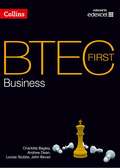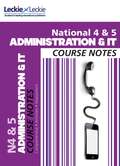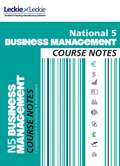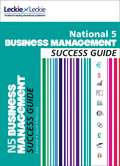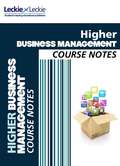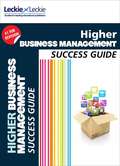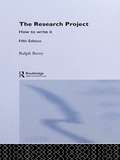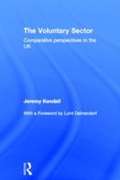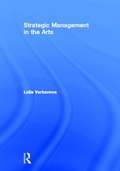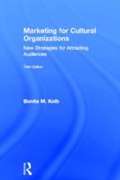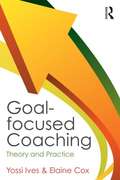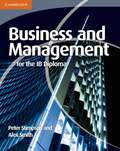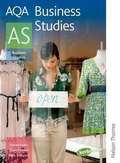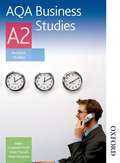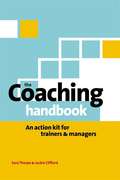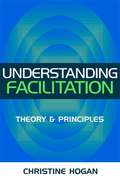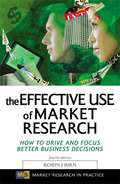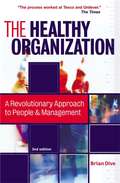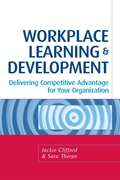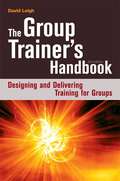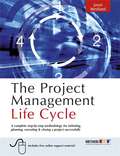- Table View
- List View
BTEC First Business: Student Book (PDF)
by Charlotte Bagley John Bevan Andrews Deans Louise StubbsBTEC First Business is a brand new textbook for the revised 2012 specification.
National 5 Administration & IT: Course Notes (PDF)
by Taylor Carol Ann Kathryn PearceThe National 4 amp; 5 Administration Course Notes help map your route through the CfE programme and provide comprehensive and authoritative guidance. Course Notes give a practical, supportive approach to help deliver the new curriculum and offer an appropriate blend of sound teaching and learning with exam and assessment guidance.nbsp;
National 5 Business Management: Course Notes (PDF)
by Lee CouttsThe National 5 Business Management Course Notes help map your route through the CfE programme and provide comprehensive and authoritative guidance. Course Notes give a practical, supportive approach to help deliver the new curriculum and offer an appropriate blend of sound teaching and learning with exam and assessment guidance.
National 5 Business Management Success Guide (PDF)
by Anne RossTopics are in user-friendly sections helping you plan your revision. Quick Tests provide the practice that learning experts say is essential for effective recall.
CfE Higher Business Management Course Notes (PDF)
by Lee CouttsThe CfE Higher Business Management Course Notes helps teachers and students map their route through the CfE programme, providing comprehensive and authoritative guidance for the course.
CfE Higher Business Management Success Guide (PDF)
by Derek Mcinally Anne RossCfE Higher Business Management Success Guide provides easy-to-use and value-for-money revision for all abilities and learning styles and includes guidance on the CfE Higher course and assessments structure.
The Research Project: How to Write It (6th edition)
by Ralph BerryNow in its fifth edition, this guide to project work continues to be an indispensable resource for all students undertaking research. Guiding the reader right through from preliminary stages to completion, The Research Project: How to write it sets out in clear and concise terms the main tasks involved in doing a research project, covering: * choosing a topic * using the library effectively * taking notes * shaping and composing the project * providing footnotes, documentation and a bibliography * avoiding common pitfalls. Fully updated throughout, this new edition features a chapter on making the most out of the Internet, from knowing where to start, to assessing the quality of the material found there. Other features include a model example of a well researched, clearly written paper with notes and bibliography and a chapter on getting published in a learned journal for more advanced researchers. Whether starting out or experienced in research, The Research Project: How to write it is an essential tool for success. Now in its fifth edition, this guide to project work continues to be an indispensable resource for all students undertaking research. Guiding the reader right through from preliminary stages to completion, The Research Project: How to write it sets out in clear and concise terms the main tasks involved in doing a research project, covering: * choosing a topic * using the library effectively * taking notes * shaping and composing the project * providing footnotes, documentation and a bibliography * avoiding common pitfalls. Fully updated throughout, this new edition features a chapter on making the most out of the Internet, from knowing where to start, to assessing the quality of the material found there. Other features include a model example of a well researched, clearly written paper with notes and bibliography and a chapter on getting published in a learned journal for more advanced researchers. Whether starting out or experienced in research, The Research Project: How to write it is an essential tool for success.
The Voluntary Sector: Comparative Perspectives in the UK
by Jeremy KendallServing as an introduction to the UK's voluntary sector, this book builds on the foundations lain in an earlier book by Kendall and Dahrendorf. Using a comparative approach to place the UK voluntary sector in perspective, this book considers the scope, scale, structure,nbsp;and impact of the voluntary sector's activities on society. Based on both qualitative and quantitative evidence, this informative book includes statistical mapping of the sector, as well as semi-structured interviews conducted with voluntary sector policy actors. A much-needed addition to the current literature, The Voluntary Sector provides a theoretical framework and in-depth analysis of an increasingly important area.
Arts Management (2nd edition) (PDF)
by Derrick ChongThe second edition of Arts Management has been thoroughly revised to provide an updated, comprehensive overview of this fast-changing subject. Arts managers and students alike are offered a lively, sophisticated insight into the artistic, managerial and social responsibilities necessary for those working in the field. With new cases studies and several new chapters, Derrick Chong takes an interdisciplinary approach in examining some of the main impulses informing discussions on the management of arts and cultural organizations. These are highly charged debates, since arts managers are expected to reconcile managerial, economic and aesthetic objectives. Topics include: arts and the State, with reference to the instrumentalism of the arts and culture business and the arts ownership and control of arts organizations arts consumption and consumers, including audience development and arts marketing managing for excellence and artistic integrity financial investing in the arts, namely fine arts funds and theatre angels philosophies of philanthropy Incorporating a deliberately diverse range of sources, Arts Management is essential reading for students on arts management courses and provides valuable insights for managers already facing the management challenges of this field. The second edition of Arts Management has been thoroughly revised to provide an updated, comprehensive overview of this fast-changing subject. Arts managers and students alike are offered a lively, sophisticated insight into the artistic, managerial and social responsibilities necessary for those working in the field. With new cases studies and several new chapters, Derrick Chong takes an interdisciplinary approach in examining some of the main impulses informing discussions on the management of arts and cultural organizations. These are highly charged debates, since arts managers are expected to reconcile managerial, economic and aesthetic objectives. Topics include: arts and the State, with reference to the instrumentalism of the arts and culture business and the arts ownership and control of arts organizations arts consumption and consumers, including audience development and arts marketing managing for excellence and artistic integrity financial investing in the arts, namely fine arts funds and theatre angels philosophies of philanthropy Incorporating a deliberately diverse range of sources, Arts Management is essential reading for students on arts management courses and provides valuable insights for managers already facing the management challenges of this field.
Strategic Management in the Arts
by Lidia VarbanovaStrategic Management in the Arts looks at the unique characteristics of organisations in the arts and culture sector and shows readers how to tailor a strategic plan to help these diverse organizations meet their objectives. Strategic management is an essential element that drives an organisation's success, yet many cultural organizations have yet to apply strategic thinking and entrepreneurial actions within the management function. Varbanova reviews the existing theories and models of strategic management and then relates these specifically to cultural organisations. Also included are sections on entrepreneurship and innovations in the arts, considering the concept of a 'learning organisation' - an organisation able to adapt its strategy within a constantly changing, complex environment. The book is structured to walk the reader through each element of the strategic plan systematically. With a fresh approach, key questions, examples, international cases to connect theory with practice and suggestions for further reading, this book is designed to accompany classes on strategic planning, cultural management or arts management. Strategic Management in the Arts looks at the unique characteristics of organisations in the arts and culture sector and shows readers how to tailor a strategic plan to help these diverse organizations meet their objectives. Strategic management is an essential element that drives an organisation's success, yet many cultural organizations have yet to apply strategic thinking and entrepreneurial actions within the management function. Varbanova reviews the existing theories and models of strategic management and then relates these specifically to cultural organisations. Also included are sections on entrepreneurship and innovations in the arts, considering the concept of a 'learning organisation' - an organisation able to adapt its strategy within a constantly changing, complex environment. The book is structured to walk the reader through each element of the strategic plan systematically. With a fresh approach, key questions, examples, international cases to connect theory with practice and suggestions for further reading, this book is designed to accompany classes on strategic planning, cultural management or arts management.
Marketing for Cultural Organizations: New Strategies for Attracting Audiences (3rd edition) (PDF)
by Bonita M KolbMarketing for Cultural Organizations presents traditional marketing theory with a focus on the aspects most relevant to arts or cultural organizations. The book explains how to overcome the division between the concepts of high art and popular culture by targeting the new tech savvy cultural consumer. As arts patronage has declined, and given new technological advances, arts organizations have had to adapt to a new environment and compete for an audience. This edition emphasizes visitor or audience participation, as well as the use of social media in attracting and maintaining an audience. Learning to harness social media and technology in order to encourage a dialogue with its audience is of primary importance for arts organizations. This book covers: - Cost effective methods of researching the audience using technology - Developing a consistent, branded online message - Using social media to increase audience engagement, and involve them in the creative process With an approach that is jargon-free and focused on practical application, this book is designed for both undergraduate and graduate students of arts marketing and cultural management. Marketing for Cultural Organizations presents traditional marketing theory with a focus on the aspects most relevant to arts or cultural organizations. The book explains how to overcome the division between the concepts of high art and popular culture by targeting the new tech savvy cultural consumer. As arts patronage has declined, and given new technological advances, arts organizations have had to adapt to a new environment and compete for an audience. This edition emphasizes visitor or audience participation, as well as the use of social media in attracting and maintaining an audience. Learning to harness social media and technology in order to encourage a dialogue with its audience is of primary importance for arts organizations. This book covers: - Cost effective methods of researching the audience using technology - Developing a consistent, branded online message - Using social media to increase audience engagement, and involve them in the creative process With an approach that is jargon-free and focused on practical application, this book is designed for both undergraduate and graduate students of arts marketing and cultural management. 9780415626972 9780203102367
Goal-focused Coaching: Theory and Practice (PDF)
by Yossi Ives Elaine CoxThis book offers a comprehensive, practical guide to goal-focused coaching. Addressing a significant gap in the literature, Ives and Cox contextualize goal-focused coaching within the broader coaching framework and explain the efficacy of this approach across a number of contexts and applications. The book draws on behavioral science, rather than humanistic psychology, to provide a well-researched, evidence-based guide that include: A detailed examination of the theoretical underpinnings of this approach, A discussion of the skills, models and formats for goal-focused coaching, Cutting edge insights into barriers to coaching and managing the coaching relationship, Summaries, vignettes, references, and diagrams to aid learning, Goal-focused Coaching will be of interest to students taking classes in coaching, as well as professional executive coaches.
Business and Management for the IB Diploma (PDF)
by Alex Smith Peter StimpsonTailored to the thematic requirements and assessment objectives of the IB syllabu Designed for class use and independent study. It includes learning objectives and summaries; integrated Theory of Knowledge material; text in clear sections, following the IB syllabus structure and content specifications; clear, accessible English for students whose first language is not English; exam-style practice questions and a chapter on assessment and exam techniques. It features the following topics: Business Organisation and Environment; Human Resources; Accounts and Finance; Marketing; Operations Management and Business Strategy.
AQA Business Studies AS: Textbook (PDF)
by Foden Steven Stimpson Peter Mansell DianeAQA Business Studies is the only set of resources to have been developed with, and exclusively endorsed by, AQA, making them the first choice to support the new AQA specification for AS and A2. With a range of truly blended resources, AQA Business Studies offers complete coverage and support through a variety of printed and electronic media. By working closely with AQA , Nelson Thornes have produced resources that will give students and teachers all they need to work through the specification with complete confidence.
AQA Business Studies A2: Textbook (PDF)
by Coupland-Smith Helen Stimpson Peter Mansell DianeAQA Business Studies is the only set of resources to have been developed with, and exclusively endorsed by, AQA, making them the first choice to support the new AQA specification for AS and A2. With a range of truly blended resources, AQA Business Studies offers complete coverage and support through a variety of printed and electronic media. By working closely with AQA , Nelson Thornes have produced resources that will give students and teachers all they need to work through the specification with complete confidence.
AQA A2 Accounting (1st edition) (PDF)
by Claire Merrills Jacqueline Halls-BryanAQA A2 Accounting has been specifically written for the AQA Accounting A Level specification. IAS terminology used throughout to help your students develop their skills. Practice questions throughout to build confidence and skills. Worked examples show layouts and step-by-step guides for accounting procedures.
AQA Economics AS: Textbook (PDF)
by Lawrence Jim Copp Alasdair Stoddard SteveAQA Economics is the only set of resources to have been developed with, and exclusively endorsed by, AQA, making them the first choice to support the new AQA specification for AS and A2. With a range of truly blended resources, AQA Economics offers complete coverage and support through a variety of printed and electronic media. By working closely with AQA , Nelson Thornes have produced resources that will give students and teachers all they need to work through the specification with complete confidence.
AQA Economics A2: Textbook (PDF)
by Lawrence Jim Stoddard SteveAQA Economics is the only set of resources to have been developed with, and exclusively endorsed by, AQA, making them the first choice to support the new AQA specification for AS and A2. With a range of truly blended resources, AQA Economics offers complete coverage and support through a variety of printed and electronic media. By working closely with AQA , OUP have produced resources that will give students and teachers all they need to work through the specification with complete confidence.
The Coaching Handbook: An Action Kit for Trainers and Managers (1st edition) (PDF)
by Sara ThorpeCoaching is proving to be one of the most popular and most effective techniques in the field of learning and development. Managers are constantly being reminded that coaching is an important part of their role in getting the best from staff, while trainers are increasingly being called upon to coach individuals in a variety of aspects of both work and life.This one-stop book aims to provide everything readers need to be able to harness this technique. Part 1 of the book provides a detailed and clearly structured step-by-step approach, which should help anyone to develop their ability to coach others. Importantly however, as well as helping to develop the skills of coaching, the authors provide valuable guidance on: where to start when coaching a colleague; how long the coaching will take; and which methods should be employed and when. Part 2 provides a range of real-life case studies from a variety of commercial and non-commercial settings that will help you to decide how coaching can best be tailored to your own organization. The final part of the book contains detailed practical exercises that can be used in a variety of settings. Each of these individual elements combine to provide the definitive coaching handbook.
Understanding Facilitation: Theory and Principles (1st edition) (PDF)
by Christine HoganFacilitation is emerging as an exciting profession. It is being used in a wide range of situations and occupations, including workplaces, leisure and health activities, organizational planning and community development. This book provides a readable introduction for newcomers to the topic aswell as a critical analysis of established and current theory for existing practitioners. It will be useful for managers, staff developers, innovators, and social and community workers.
The Effective Use of Market Research: Volume 4 (4th edition) (PDF)
by Robin BirnMore and more companies today are using market research techniques, not just to find new markets, products and customers, but also to improve management and marketing decision making and to monitor customer service. The Effective Use of Market Research looks at the circumstances in which market research is necessary, and explains what management can expect to gain from research and then analyses the type of business decisions that may be taken as a result. An organization that knows its customers and monitors its activity well, and also has a good understanding of the key research techniques it needs, is likely to develop more competitive sales, marketing and communications strategies.This latest edition of Effective Use of Market Research explains how to develop representative samples, data protection legislation and the professional ethics incorporated in the MRS Code of Conduct.
The Healthy Organization: A Revolutionary Approach to People and Management (2nd edition) (PDF)
by Brian DiveDespite the huge volume of research on organizational design, ranging from the work of management gurus and journalists to that of sociologists and behavioural scientists, most organizations remain profoundly unhealthy.In this fully updated second edition of his groundbreaking book, Brian Dive reveals that the unhealthy features of both large and small organizations all stem from the same source, namely the lack of true decision-making accountability (DMA), and he introduces a totally new approach to leadership development.Based on the author's experience at Unilever and Tesco, and more recently at Amersham, BQ and Marks Spencer, and covering research in over 50 countries, The Healthy Organization answers the recurring questions that dog an organization's development: How many people should there be in this organization? How many layers of hierarchy are necessary? What are the most effective professional development steps for employees? What career paths should individuals follow to reach fulfilment? By following the steps outlined in the book, Brian Dive reveals that healthy organizational management will lead to greater competitiveness, spark innovation and increase employee empowerment and commitment.
Workplace Learning and Development: Delivering Competitive Advantage for Your Organization (1st edition) (PDF)
by Jackie CliffordLearning and development is essential to organizational success. Training courses were traditionally used as the key method of teaching, but increasingly the focus is shifting to individuals and managers adopting a more flexible approach to learning. Organizations are being held responsible for maximizing the skills, knowledge and behaviours available to them, ensuring that employees are not solely learning new skills, but are using their existing skills to maximum effect.Workplace Learning and Development guides managers and employees through the concept of workplace learning. It identifies the variety of flexible learning strategies and methods, explains how to select the right method for a specific situation, and illustrates how these methods can add value to overall performance. Real-life examples of workplace learning are included to allow readers to gain insight into how it works and more importantly, how they could use it to address their specific needs.
The Group Trainer's Handbook: Designing and Delivering Training for Groups (3rd edition) (PDF)
by David LeighOrganizations succeed when staff are doing their jobs effectively. For this to occur, employees must be well-trained. Group training, involving two or more people, enables a collaborative approach to working and problem-solving, and ensures that participants share best practice and a consistent learning experience.Now in its third edition, The Group Trainer's Handbook is a condensed source of practical advice for anyone involved in group training. Updated with the latest thinking in group training methods, it is particularly useful for managers who are responsible for a team's professional development. It breaks down the stages of designing and developing a successful training course and all the key skills needed to deliver effective group training.Formerly published as Designing and Delivering Training for Groups .
The Project Management Life Cycle: A Complete Step-by-step Methodology for Initiating, Planning, Executing and Closing the Project (1st edition) (PDF)
by Jason WestlandThe Project Management Life Cycle reveals the unique Method 123 Project Management Methodology by defining the phases, activities and tasks required to complete a project. It's different because it describes the life cycle clearly and prescriptively, without the complex terminology rife throughout the industry. Its comprehensive coverage, consistent depth and suite of tools will help managers to undertake projects successfully.Containing hundreds of practical examples to enhance the reader's understanding of project management, the book skilfully guides them through the four critical phases of the project life cycle: initiation, planning, execution and closure. Written in a clear, professional and straightforward manner, it is relevant to the management of all types of project, including IT, construction, engineering, telecommunications and government, as well as many others.An essential guide to improving project management skills for project managers, senior managers, team members, consultants, trainers or students.
